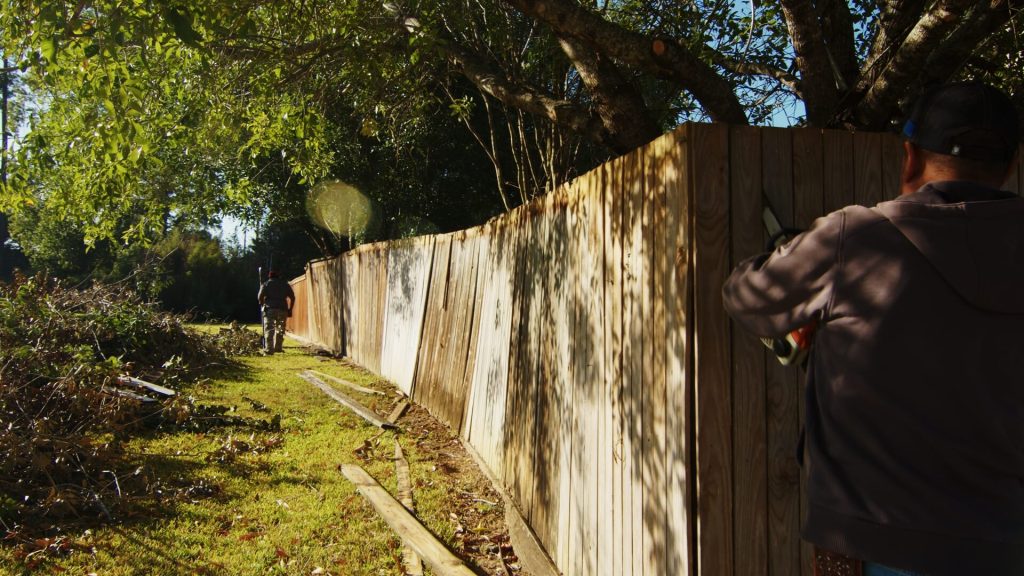Why Your Houston Fence Failed (And How to Prevent It Next Time)
Houston fence failure is what happens when posts go too shallow, concrete is wrong for our clay soils, hardware is underbuilt, or materials do not match the site.

The Real Causes of Houston Fence Failures
Most bad fences do not fail on day one. They fail in the first storm or the first long stretch of rain. A Houston fence looks fine at install, then starts to lean, rattle, or drag. That is not random chance. It is the result of rushed layout, light hardware, or concrete that never had a shot in our soil. We prevent those issues with depth, mix, drainage, and hardware that match the load and the site.
Houston Fence Killers You Can Predict
Here are the local conditions we plan for on every project:
- Clay soil movement: Wet clay expands. Dry clay shrinks. Shallow posts move.
- Storm winds: Gusts twist rails, stress weak fasteners, and pull gates out of square.
- Heat and sun: High UV punishes thin finishes and low-grade pickets.
- Standing water: Low spots around posts lead to rot, heave, and early failure.
If a plan ignores any of these, the fence will tell the truth within months.
The Top Five Failure Points We See Most
- Insufficient post depth. Posts set short lean fast. We set proper depth and bell-foot where the soil calls for it.
- Wrong concrete practice for clay. Mix and placement matter. Clay wants a base that resists lift and a shape that locks in.
- Water trapped at bases. Grade and landscaping can funnel water to the post. We adjust layout and drainage so bases breathe.
- Material mismatch. Low-grade pickets, undersized rails, and mixed fasteners do not hold up. We spec for span and load.
- Gate shortcuts. A weak frame with light hinges sags. We build square, choose rated hardware, and add a stop so the latch lives long.
Why Some Wood Fences Last 20 Years and Others Fail in 5
Longevity comes from three things: Grade 1 materials, correct installation method, and simple maintenance. Grade 1 cedar pickets have fewer knots and take stain evenly. Proper rail spacing resists twist across long runs. Right fasteners avoid staining and hold tight. Add a stain cycle that matches your sun exposure and a fence can look good and stay quiet for a very long time.
- See how we build residential fences: Wood Fences at Texas Fence
- Upgrade your gate durability and safety: Gates and Access Control
Aluminum, Steel, and Vinyl in a Humid Market
Aluminum resists corrosion well and makes sense near damp areas. Quality steel with proper coatings performs when posts and hardware are sized right. Vinyl works when rails seat firmly and expansion gaps are correct. None of these materials can overcome shallow posts or weak gates. Structure first, finish second.
Learn more about a small part that matters a lot: Screw on Wikipedia
Red Flags in Estimates
If a bid never states post depth, concrete spec, hardware brand, or gate details, expect problems. If the price sounds too good, look for missing line items like haul-off, permit support, or HOA packets. A professional scope lists depth, rail count, hardware type, and how we handle slopes and drainage.
Our Installation Standards That Stop Houston Fence Failures Before They Start
We set posts to proper depth and shape the base to resist movement. We choose mixes that cure strong and place them correctly for clay. We size rails for the span and set pickets for clean lines and airflow. We build gates on square frames, use rated hinges and latches, and add stops so closures stay quiet. We match fasteners to the wood and the coating so stains do not bleed through your Houston fence finish.
Maintenance That Actually Extends Life
Good builds last longer with a few simple habits:
- Keep soil and mulch off wood bases.
- Rinse irrigation overspray and grass clippings from fence lines.
- Maintain stain cycles on cedar based on sun exposure.
- Check hinges, latches, and strike plates seasonally.
- Trim heavy limbs that pound rails in storms.
Service and Warranty That Back You Up
We stand behind our work. If something shifts or squeaks, call us. Our team checks depth, hardware, and alignment. We correct what needs attention so your fence returns to quiet service.

FAQ
Why did my gate drag after the first big rain?
The posts or the frame moved. We prevent that with deeper posts, square frames, rated hinges, and a stop that protects the latch.
Is cedar really worth it?
Grade 1 cedar holds shape, takes stain evenly, and looks better longer. With proper install and maintenance, it is a strong value.
Can you fix a fence that was set too shallow?
Yes. We reset posts to proper depth, replace rails if needed, and square the gate.
How do you choose concrete?
We match mix and placement to soil and load, then allow for proper curing.
Takeaway
A Houston fence fails when structure, materials, and hardware do not match the site. Texas Fence builds for depth, drainage, wind, and daily use so your fence stays straight, quiet, and strong. When you want a professional result from a trusted local expert, choose Texas Fence. Service You Can Count On, From Start To Finish!








